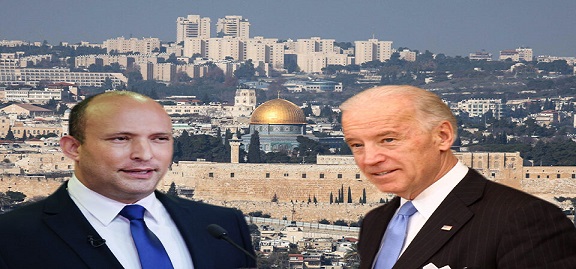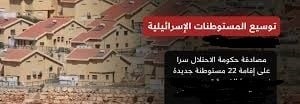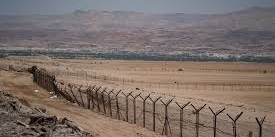By: Madeeha Al-A’raj
The National Bureau for defending land and resisting settlements ( nbprs ) stated in its latest weekly report , that the Palestinians fear the new US Administration ambiguous position on settlement, and the Israeli settlement activities in the West Bank including East Jerusalem. An ambiguity that can be understood by the Israeli government as a green light for looting the Palestinian land in contravention of international legitimacy resolutions, as Israeli sources indicated that the Biden administration didn’t put pressure on Israel regarding settlement construction in the West Bank, as long as, the matter is related to plans and projects approved by the previous Israeli government. Those sources made it clear that the current situation in settlement construction will continue as is.
Two days on their meeting, the Israeli government as well as in the competent Israeli circles returned to discuss the “E1” settlement project in the occupied Jerusalem. Knowing that project extends over large areas of land, where they are planning to build more than 3,400 settlement units, hotels and Israeli industrial zones. Within the context, the occupation government, headed by Bennett, is pushing hard towards implementing the “E1″ settlement plan on an area of 12,443 dunums of occupied East Jerusalem land. Where the so-called ‘Supreme Council for Planning and Building at the Civil Administration” of the occupation will hold a hearing during the coming days, to discuss the objections to the settlement projec’ in preparation for approval to start implementing it. Taking into account that the occupation has allocated about NIS 26 million to develop plans, designs and conduct engineering surveys for the settlement project. The project comes within the so-called “Greater Jerusalem” project, and aims to link the settlement of “Ma’ale Adumim” to the city of Jerusalem within the apartheid wall, and besiege a number of Bedouin communities that have about 7,000 people.
The project included the construction of thousands of settlement units, hotels, and industrial and tourist areas extending from the eastern part of Jerusalem to the Dead Sea, in addition to establishing streets and a separation of settlements to separate the West Bank and tighten control over the strategic area. In turn, the left-wing Israeli Peace Now movement said that ‘the Supreme Planning Council’ sent a summons on Sunday for a hearing on October 4 and 18, to discuss the objections submitted by the Peace Now Movement, the Ir Amim Association and many others to plans for building 3,412 housing units in E1″.
On the other hand, the occupation municipality in Jerusalem launched a plan to “settle the real estate rights” with the aim of denying many Palestinian rights in real estate, laying hands on them and confiscating them under the pretext of lacking sufficient ownership proofs or reactivating the law of the Custodian of Absentees’ Property within the official public policy aimed at emptying them from their residents and then Judaizing them. Letters were sent by the so-called judge of land settlement in Jerusalem, David Rothenberg, to the Palestinian citizens of the occupied East Jerusalem informing them that ‘in the coming period we will begin to settle the land in the city.’ On March 19th, 2018, the former Israeli Minister of Justice, currently, Minister of Interior in the Bennett’s government, Ayelet Shaked, announced a notice regarding the opening of a real estate rights settlement file or the announcement of a land settlement in the city of Jerusalem, which included basins in Sur Baher, Beit Hanina, Sheikh Jarrah and Hizma .
As for the Civil Coalition for Palestinian Rights in Jerusalem, it warned that the Israeli government’s decision to start settling real estate rights and registering land in East Jerusalem would confiscate about 60% of the property in the city, stressing that “the most dangerous thing in the property settlement is to activate and implement the Absentees’ Property Law, as property settlement is forced Jerusalemites have to pay high taxes when registering property in the absence of the necessary documents to prove ownership, which means confiscating the land for the lack of data or a comprehensive survey of the property in the city.
In parallel, the so-called ‘Board of Directors of the Jewish National Fund’ approved a plan aimed at registering and organizing land in East Jerusalem for its benefit. The management of the fund seeks to register real estate in order to organize it for the benefit of the Jews in all areas of Jerusalem as well as the West Bank. The cost of implementing the plan is about NIS 100 million shekels, and expected to take 5 years to examine the land purchase transactions carried out by the Fund before and/or after 1948, and they were not registered with the real estate registry offices, and they are documented only in its records and annexes. The Fund works with unprecedented activity to encourage settlers to buy real estate in the West Bank and Jerusalem with the aim of controlling them and evacuating Palestinian residents. Such a step would, in some cases, lead to the evacuation and displacement of Palestinians residing in some of those areas.
In accordance to the Jewish National Fund, the documents of the West Bank include 360 properties, of which 170 contracts were purchased and registered after 1967. Additional real estate is located in Jerusalem, and these lands cover an area of approximately 2,500 dunums, and these assets have been managed by the General Guardian since 1967. According to the Jewish National Fund’s estimation, some properties are inhabited by Palestinians, and in cases in which the Fund records properties inhabited by Palestinians, the Israeli Land Authority, which actually manages the properties, will have to evict them, including properties in the Jerusalem area located in the neighborhoods of Sheikh Jarrah and Beit Hanina.
The Jewish National Fund had previously demanded the evacuation of Palestinian lands, for example, in 2019, a café and a Palestinian family were evacuated in the Bethlehem area, and shortly after that a settlement outpost was built, as well as in the Silwan neighborhood of Jerusalem, a Palestinian family has been fighting a legal battle for 20 years as its home was transferred to the Jewish National Fund.
List of Israeli Assaults over the Last Week Documented by the National Bureau:
Jerusalem:
- Forcing a Jerusalemite family to demolish their 3-house, inhabited by 13 people, in the Al-Ashqaria Neighborhood in the Beit Hanina town. Otherwise, they will pay high fees. Moreover, forcing another to demolish his own house in the village of Jabal Mukaber under the pretext of not having a building permit.
Hebron:
- Destroying 9 vehicles in the Jaber Neighborhood in the old city of Hebron while passing through the ‘Worshippers Road’, which extends from the settlement of ‘Kiryat Arba’ through Wadi Al-Hussein, Wadi Al-Nasara, Al-Salaymeh Neighborhood, and Al-Jaber Neighborhood, all the way to the Ibrahimi Mosque.
- Eight-year-old Abdul-Rahim Al-Jabari got injured after he was run over by an Israeli settler, who fled the scene near the Ibrahimi Mosque.
Bethlehem:
- Notifying to stop working in a mosque under construction, as well as in 4 inhabited houses, each of them has an area of 130m2 in the areas of Qornet Ad-Dams, Ain Fares and Al Kabara. And notifying to stop working on 5 houses under construction in addition to retaining walls in the Wadi Al-Al Murba area, under the pretext of not having a building permit.
- Storming the Tahdi 5 School in the Beit Tamar area, east of Bethlehem for the second time in a row within days in preparation for its demolition, notified those in charge of it to summon before the Israeli court on Oct. 10th.
Ramallah:
- Settlers stormed the Ras al-Tin Bedouin community, east of Ramallah, and roaming near the Al-Tahadi School, gave a lecture to the Knesset members on the importance of the area and presented maps of the West Bank to show the importance of demolishing the community and displacing its residents.
Nablus:
- Demolishing 2 houses, one of them under construction in addition to a water well in the Duma town, southeast of Nablus, as well as uprooting fruitful trees in the gardens.
- Demolishing an agricultural facility in the Rahiya area, and handing several demolition notices under the pretext of being in area classified as “C”.
- Attacking a house south of the Burin village, smashing its windows and destroying plants in its surroundings.
- Bulldozing one of the roads leading to Jabal Sabih, hours before the start of the weekly march against the outpost on the top of the mountain.
Jenin:
- Placing caravans in a mountainous area near the Barta’a military checkpoint from the southern side of the town, in preparation for the establishment of a new settlement outpost.
Salfeet:
- Bulldozing agricultural lands belonging to the village of Haris in the western region in favor of the expansion of the Kiryat Netafim settlement and the Berkan and Ariel” factories, and the Rava-va settlement.
- Notifying to stop work and construction in an agricultural facility in the Al-RasArea, west of the city of Salfit.
- Stopping the citizens from working on their lands located near the entrance to the town of Qarawat Bani Hassan, west of Salfit, under the pretext of being located in C area.
Jordan valley:
- Demolishing 3 tents in the Khirbet Ibziq, northeast of Tubas including 2 tents with an area of 120m2 and a 60m2 tent.
 المكتب الوطني للدفاع عن الارض ومقاومة الاستيطان منظمة التحرير الفلسطينية
المكتب الوطني للدفاع عن الارض ومقاومة الاستيطان منظمة التحرير الفلسطينية




